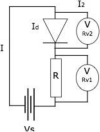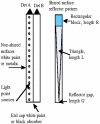New Directions for dMiCE - a Depth-of-Interaction Detector Design for PET Scanners
- PMID: 19212455
- PMCID: PMC2638085
- DOI: 10.1109/NSSMIC.2007.4436948
New Directions for dMiCE - a Depth-of-Interaction Detector Design for PET Scanners
Abstract
Our laboratory has been developing a depth-of-interaction (DOI) detector design based on light sharing between pairs or quadlets of crystals. Work to date has been utilizing 2×2 mm cross section crystals carefully positioned on a multi-anode PMT. However, there is still significant light sharing in the PMT glass envelope and current PMT designs do not allow one-on-one coupling for arrays of smaller cross section crystals. One-on-one coupling is optimal for implementing the DOI estimator. An alternative to PMTs is to take advantage of progress in fabrication of metal resistive-layer semiconductor photodetectors to provide arrays with one-on-one crystal coupling. We report on our initial tests of one manufacturer's devices. The photodetector (MAPD) and scintillator combination (LFS-3) are both products of Zecotek. The LFS-3 crystal is a variant of LFS that has a better spectral match to the MAPD. Measurements show performance equivalent to or better than that obtained with PMTs and LSO, LFS, or LYSO crystals. For example, 2×2×20 mm crystals are providing 11% energy resolution. The high gain of such devices allow flexibility in designs for both the array and the supporting electronics. We are proceeding with the dMiCE development based on the use of MAPD and LFS-3 arrays.
Figures















References
-
- Miyaoka RS, Lewellen TK, Yu H, McDaniel DL. Design of a Depth of Interaction (DOI) Pet Detector Module. IEEE Trans. Nucl. Sci. 1998;45(3):1069–73.
-
- Miyaoka RS, Janes M, Lee KS, Park B, Kinahan PE, Lewellen TK. Development of a Prototype Micro Crystal Element Scanner (Mices): Quickpet II. Molecular Imaging. 2005:117–27. - PubMed
-
- Miyaoka RS, Kohlmyer SG, Lewellen TK. A Second Generation Micro Crystal Element (Mice2) Detector. J. Nucl. Med. 2001:110P. - PubMed
-
- Miyaoka RS, Laymon CM, Janes M, Lee K, Kinahan PE, Lewellen TK. Recent Progress in the Development of a Micro Crystal Element (Mice) Pet System. Proceedings of the 2002 IEEE Nuclear Science Symposium and Medical Imaging Conference; Norfolk. 2002. pp. 1287–91.
Grants and funding
LinkOut - more resources
Full Text Sources
Other Literature Sources
